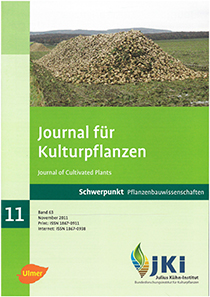Assessment of productivity and profitability of sole and double-cropping for agricultural biomass production
DOI:
https://doi.org/10.5073/JfK.2011.11.03Keywords:
Maize, forage sorghum, sorghum-sudangrass, energy crops, cropping systems, economyAbstract
Double-crop (DC) systems are receiving serious consideration as cropping alternative for agricultural biomass production in Germany. In this study the productivity and economics of DC and sole-crop (SC) systems were compared from 2007 to 2009 at three climatically diverse sites of Germany. The warm season crops maize (Zea mays L.), forage sorghum [Sorghum bicolor (L.) Moench] and sorghum-sudangrass [S. bicolor (L.) Moench × S. sudanense (Piper) Stapf] were either grown as sole crops or as second crop following winter rye (Secale cereale L.). The winter rye first crop was harvested premature at early-to-mid May (early) or early June (late). While the winter rye was grown under rainfed conditions, maize, forage sorghum, and sorghum-sudangrass were grown with or without irrigation. Winter rye produced an aboveground dry matter yield (DMY) of 5.2 t ha–1 at early harvest and 9.0 t ha–1 at late harvest. The highest yielding DC system (rye-maize) out-yielded the most productive SC system (maize) by 3.6 t ha–1 (23%) under rainfed conditions and by 5.2 t ha–1 (24%) with irrigation. Irrigation increased DMY of sole crops by 5.3 t ha–1 (37%), of early sown second crops by 5.6 t ha–1 (43%), and of late sown second crops by 6.8 t ha–1 (77%). Under rainfed conditions, the higher DMY of the DC as compared with the SC systems did not compensate the higher production costs. With irrigation, however, the rye-maize DC achieved higher contribution margins than SC maize at two of the three experimental sites.
Published
Issue
Section
License
The content of the journal is licensed under the Creative Commons Attribution 4.0 License. Any user is free to share and adapt (remix, transform, build upon) the content as long as the original publication is attributed (authors, title, year, journal, issue, pages).
The copyright of the published work remains with the authors. The authors grant the Journal of Cultivated Plants, the Julius Kühn-Institut and the OpenAgrar repository the non-exclusive right to distribute and exploit the work.







